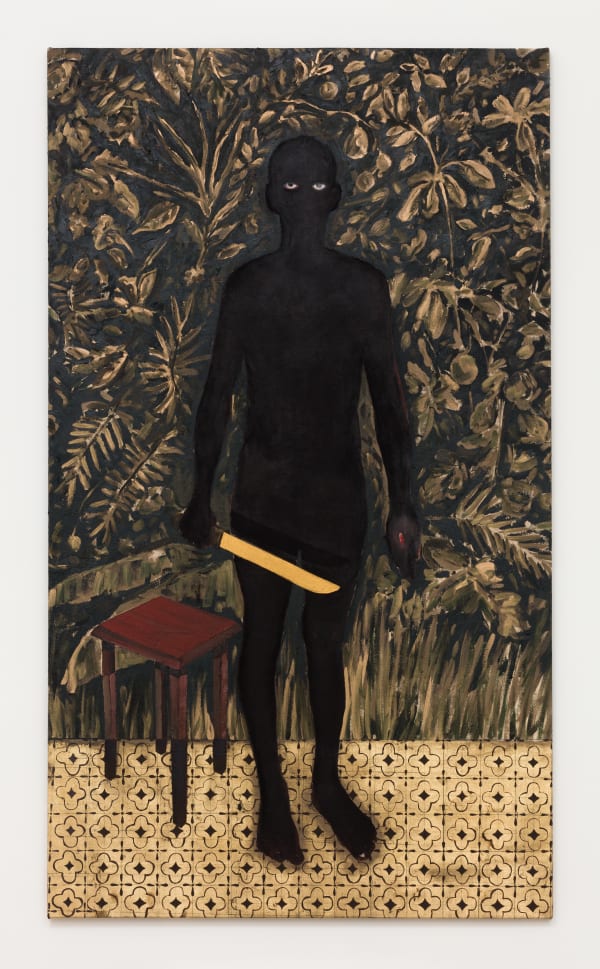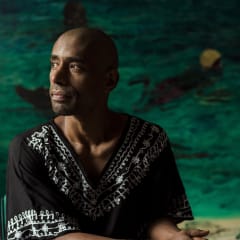Antônio Obá
Past exhibition
Overview
Mendes Wood DM has the pleasure to present the first solo show in São Paulo by the artist Antônio Obá. The artworks exhibited encompass a diversity of supports and media, such as painting, monotype, installation and performance.
The artist incorporates Brazilian religious icons to question a racial and political identity memory. A number of ex-votos – objects offered to the gods as gratitude for fulfilling a vow – are displayed throughout the room, including ordinary materials, such as horse teeth, horseshoes and nails, amongst others, which, in the context of a syncretic discourse, articulate the proposition of an exchange with the gods. The idea of a symbolic offering through the ex-votos challenges their own purpose.
These objects of gratitude for a wish granted by a god are, in this case, in the artist’s own words, records of a broken body, manifested in the wood as a stain that cannot be forgotten, but that enable a discussion on the interaction between the ritualistic and historic perspectives that each person carries.
These religious icons, along with the artist’s contemporary experiences and beliefs, establish a network of senses connecting our times with a past deleted by history. The monotypes that imprint the artist’s own body onto canvas reiterate his interest in re-signifying the body in rites and social situations, transfiguring his intentions in the pictorial field beyond the religious signs, raising a discussion about the black body, not only physical, but from a historical and social perspective.
In the field of art historiography, Obá’s work encourages an investigation on the relationships of influence and interchange in the construction of Brazilian culture, the erasing of the black element of the history of Brazilian art that, nonetheless, gives room to an act of resistance and reflection on the idea of a national identity.
The artist incorporates Brazilian religious icons to question a racial and political identity memory. A number of ex-votos – objects offered to the gods as gratitude for fulfilling a vow – are displayed throughout the room, including ordinary materials, such as horse teeth, horseshoes and nails, amongst others, which, in the context of a syncretic discourse, articulate the proposition of an exchange with the gods. The idea of a symbolic offering through the ex-votos challenges their own purpose.
These objects of gratitude for a wish granted by a god are, in this case, in the artist’s own words, records of a broken body, manifested in the wood as a stain that cannot be forgotten, but that enable a discussion on the interaction between the ritualistic and historic perspectives that each person carries.
These religious icons, along with the artist’s contemporary experiences and beliefs, establish a network of senses connecting our times with a past deleted by history. The monotypes that imprint the artist’s own body onto canvas reiterate his interest in re-signifying the body in rites and social situations, transfiguring his intentions in the pictorial field beyond the religious signs, raising a discussion about the black body, not only physical, but from a historical and social perspective.
In the field of art historiography, Obá’s work encourages an investigation on the relationships of influence and interchange in the construction of Brazilian culture, the erasing of the black element of the history of Brazilian art that, nonetheless, gives room to an act of resistance and reflection on the idea of a national identity.
Works
-
 Antonio Obá, Interlocução I/ Sankofar, 2019
Antonio Obá, Interlocução I/ Sankofar, 2019 -
 Antonio Obá, Sentinela, 2019
Antonio Obá, Sentinela, 2019 -
![Antonio Obá, Figura com melancia [Figure with Watermelon], 2019](data:image/gif;base64,R0lGODlhAQABAIAAAAAAAP///yH5BAEAAAAALAAAAAABAAEAAAIBRAA7) Antonio Obá, Figura com melancia [Figure with Watermelon], 2019
Antonio Obá, Figura com melancia [Figure with Watermelon], 2019 -
 Antonio Obá, Negro Spiritual, 2019
Antonio Obá, Negro Spiritual, 2019 -
 Antonio Obá, Um Egum, 2019
Antonio Obá, Um Egum, 2019 -
 Antonio Obá, Yauaretê, 2019
Antonio Obá, Yauaretê, 2019 -
 Antonio Obá, Tocaia, 2019
Antonio Obá, Tocaia, 2019 -
 Antonio Obá, Strange Fruit IV, 2018
Antonio Obá, Strange Fruit IV, 2018 -
 Antonio Obá, São Jorge, 2019
Antonio Obá, São Jorge, 2019 -
 Antonio Obá, Strange Fruits - Goiabeira, 2019
Antonio Obá, Strange Fruits - Goiabeira, 2019 -
 Antonio Obá, Prece-Aroni, 2019
Antonio Obá, Prece-Aroni, 2019 -
 Antonio Obá, Fábula dos Erês, 2019
Antonio Obá, Fábula dos Erês, 2019
Installation Views



![Antonio Obá, Figura com melancia [Figure with Watermelon], 2019](https://artlogic-res.cloudinary.com/w_600,c_limit,f_auto,fl_lossy,q_auto,dpr_auto/artlogicstorage/mendeswooddm/images/view/ff31672cf23ad6eb0a28311c6f86e1e8j/mendeswooddm-antonio-ob-figura-com-melancia-figure-with-watermelon-2019.jpg)










